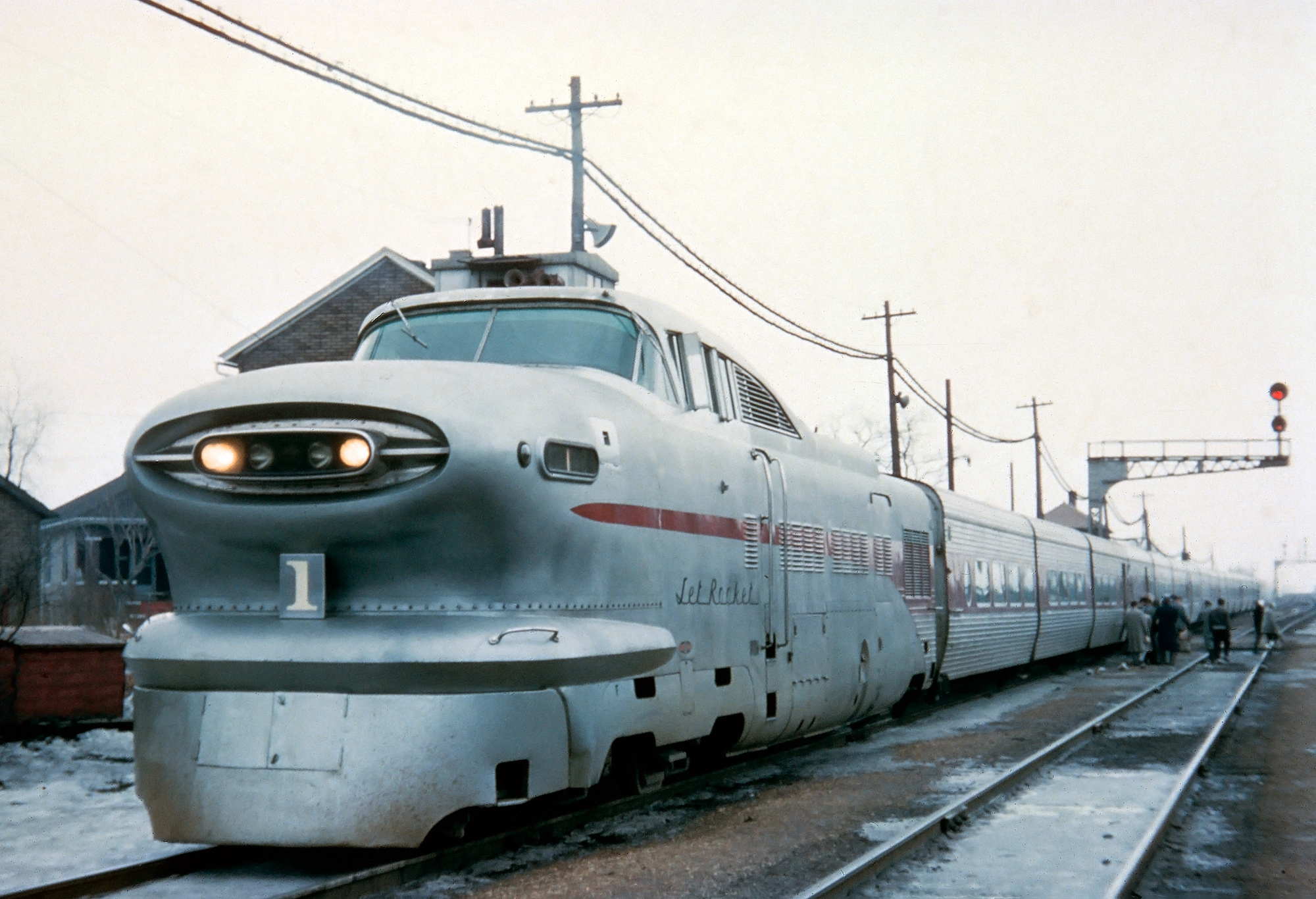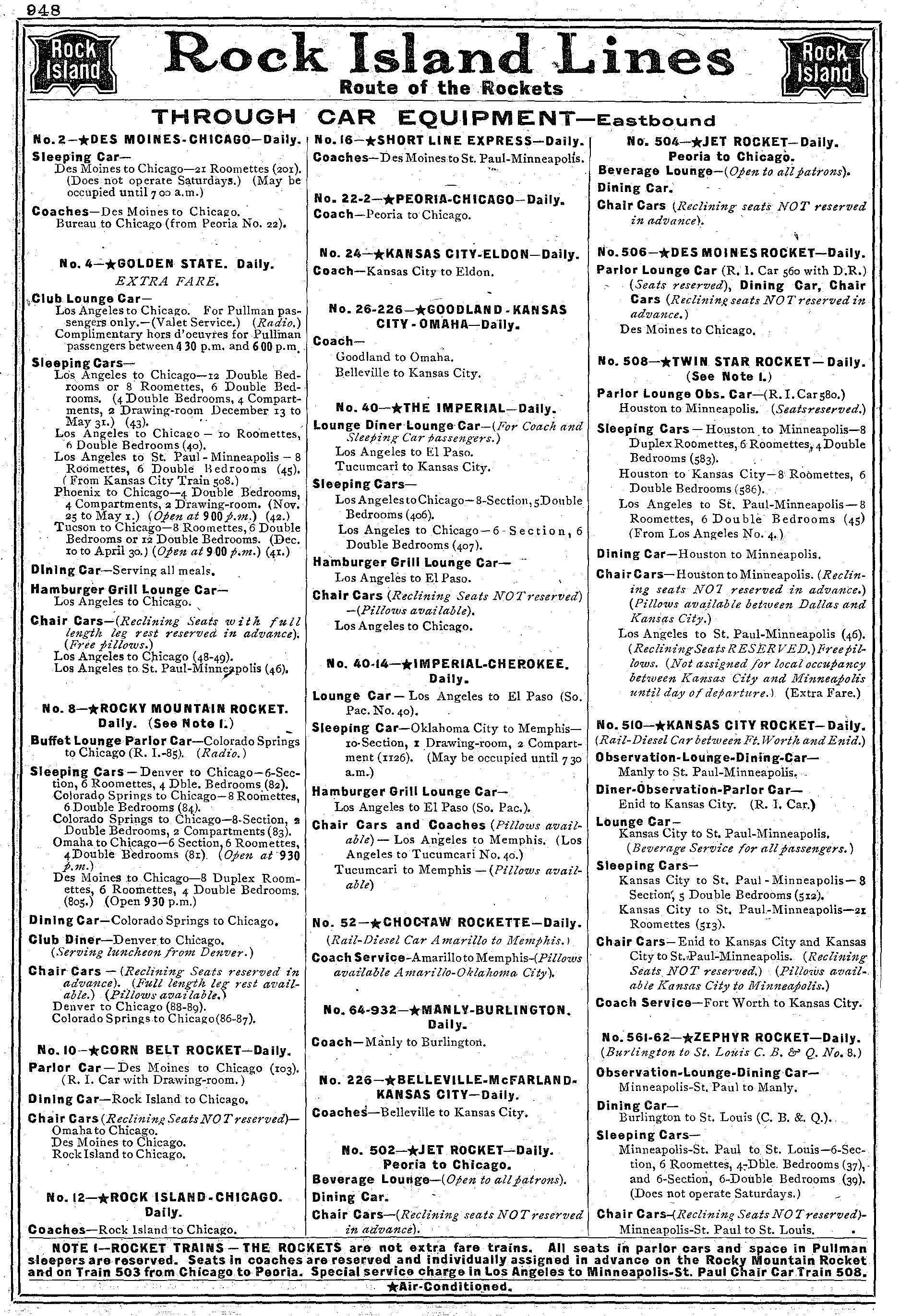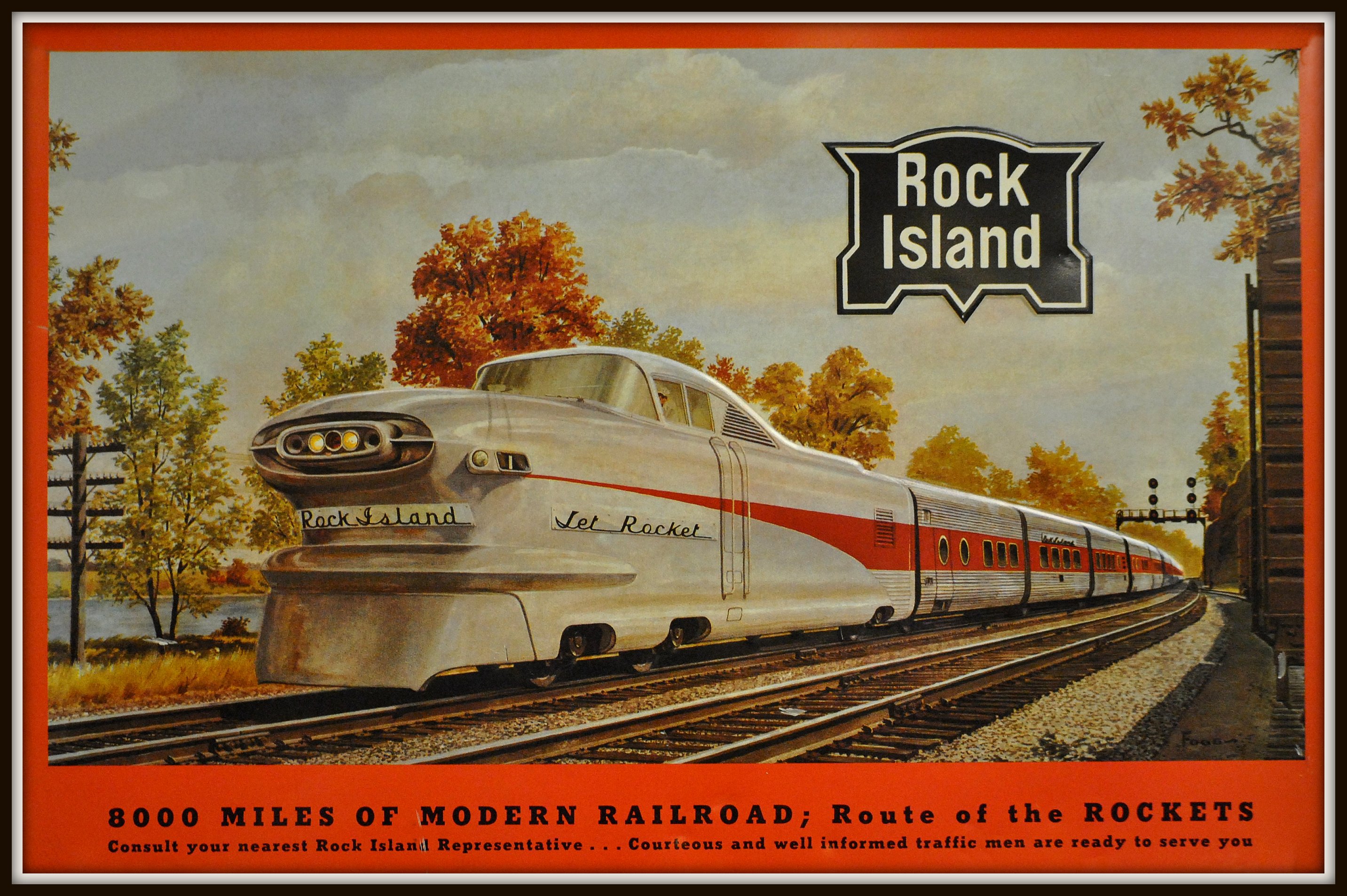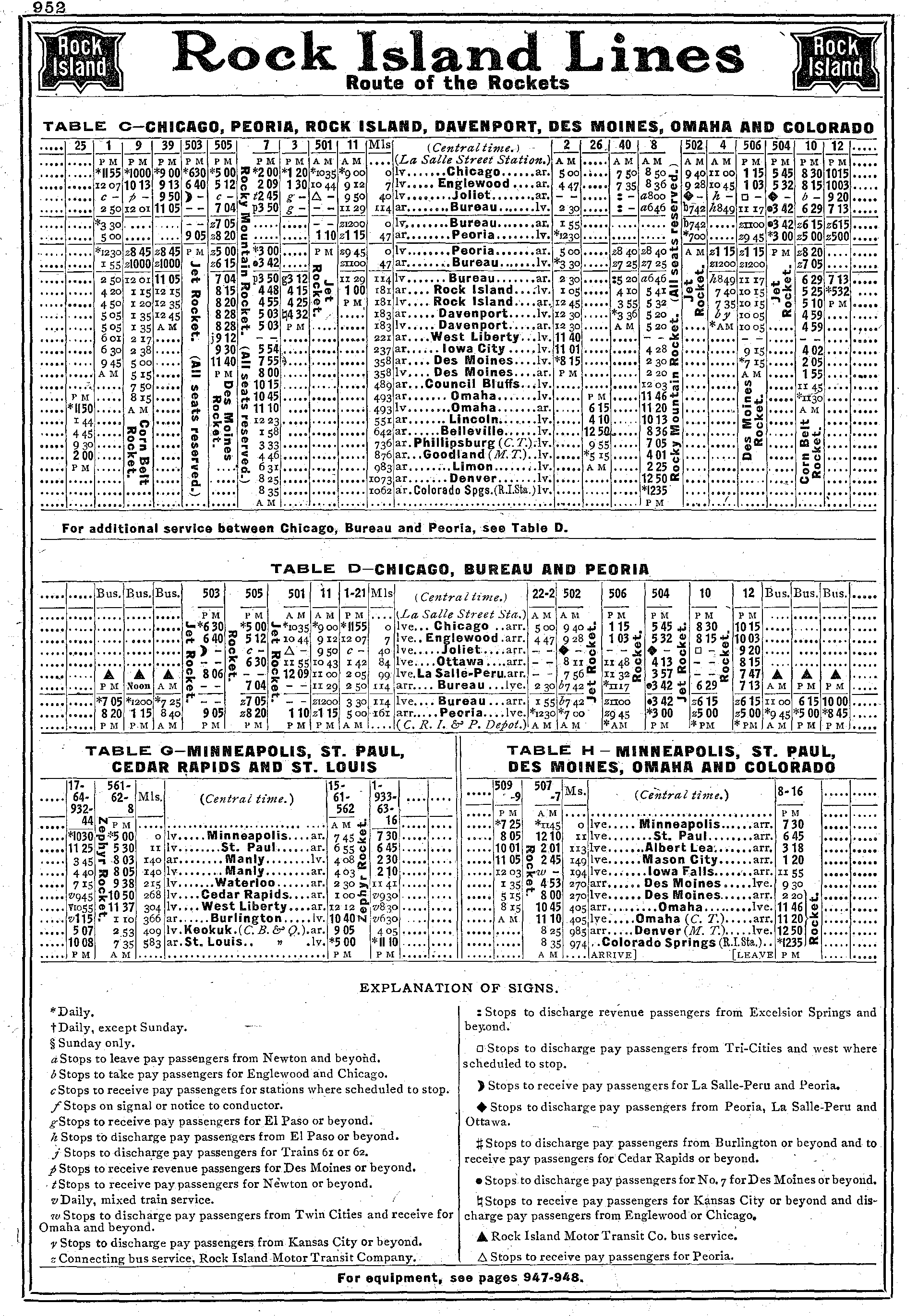"Jet Rocket" (Train): Consist, Timetable, Photos
Last revised: November 7, 2024
By: Adam Burns
Despite the railroad's seemingly constant financial troubles, the Rock Island was a big proponent of streamliners and would eventually field an entire fleet of "Rockets" serving the far reaches of its system.
When Spain's newfangled lighweight TALGO design made its way to the United States during the 1950s, the Rock was quick to jump on board and purchased a set from American Car & Foundry.
Interestingly, the TALGO - an acronym for Train, Articulated, Lightweight, Goicoechea (the train's design), Oriol (the train's financier/business partner) - was a unique spin on an old concept.
The lightweight trainsets harkened back to the early streamliners of the 1930s but were intended to reduce operating costs while not sacrificing ride quality.
Rock Island's one and only set operated in regular service for less than two years before the railroad transferred it to Chicago commuter service. Here it remained for a few short years before being scrapped in 1965.
Photos
 Rock Island's former "Jet Rocket" is seen here stopped in Blue Island, Illinois, circa 1958, after the trainset had been relegated to commuter service. The train carried a very similar appearance to the famous "Aerotrain" and was originally used on the Chicago-Peoria run. It was powered by an LWT-12 locomotive and cars manufactured by American Car & Foundry. The cars were slightly different than those utilized on the "Aerotrain." Nevertheless, it was not successful. The Rock kept its one and only set in service for less than two years (1956-1957) before transferring it to commuter service. American-Rails.com collection.
Rock Island's former "Jet Rocket" is seen here stopped in Blue Island, Illinois, circa 1958, after the trainset had been relegated to commuter service. The train carried a very similar appearance to the famous "Aerotrain" and was originally used on the Chicago-Peoria run. It was powered by an LWT-12 locomotive and cars manufactured by American Car & Foundry. The cars were slightly different than those utilized on the "Aerotrain." Nevertheless, it was not successful. The Rock kept its one and only set in service for less than two years (1956-1957) before transferring it to commuter service. American-Rails.com collection.TALGO
The TALGO project was a Spanish design dating back to the late 1930s and early 1940s invented by Spanish engineer Alejandro A. Goicoechea.
The articulated trainset, featuring an ultra-lightweight trainset (aluminum), and tubular carbody (equipped with a frame composed of low-alloy, high-tensile steel), was intended to reduce maintenance and operating costs while not sacrificing passenger comfort.
In addition, instead of sporting conventional swivel trucks it utilized individual wheel pairs. The low-profile concept was intended to reduce wheel wear while also enabling higher speeds through curves. The ability to perform the latter was one way in which TALGO was designed to reduce operating costs.
At A Glance
February 11, 1956 - August 20, 1957 |
|
501 (westbound) 502 (eastbound) | |
LaSalle Street Station (Chicago) Rock Island Depot (Peoria) |
Another weight-savings measure was the use of interior plastics. Today, such measures are viewed as somewhat cheap and tacky although at the time were regarded as a new, revolutionary material.
Finally, TALGO was equipped with an on-board generator that produced three-phase AC power for lighting and heating/cooling.
In Spanish, the TALGO acronym meant; Tren, Articulado, Ligero, Goicoechea-Oriol. Oriol was short for José Luis de Oriol y Urigüen who was Goicoechea's business partner in the project.
Consist
American Car & Foundry
In 1949, American Car & Foundry was contracted to produce TALGO trainsets for the Spanish National Railways (Red Nacional de los Ferrocarriles Españoles, or Renfe) and was also licensed to build a demonstrator set to test in America.
At the time, streamlining was all the rage in the United States and the new lightweight sets were viewed as a means of reducing costs while also not sacrificing either ridership or passenger comforts.
Interestingly, American lines had tested very similar semi-articulated sets back in the 1930s and came away dissatisified with the design.
The lack of redundancy meant the cars non interchangeable and if an issue developed with a single car - or the power car - the entire trainset was sidelined.
Rock Island
The Rock Island had shown much interest in the TALGO design following the ACF test train which operated on the Lackawanna between Hoboken and Dover, New Jersey in 1949.
Interestingly, it was seemingly the only American road to do so as no orders were taken at that time. In 1954 ACF carried out another test train that was more heavily marketed throughout the U.S.
In June, 1954 Rock Island placed an order for a TALGO set at a cost of $600,000, which was to be led by one of Electro-Motive's new streamlined LWT-12 diesels. With a price tag of around $188,000, the entire trainset cost $788,000 according to Time Magazine.
The LWT-12 was a unique and fascinating streamlined locomotive that had a classic-1950s futuristic appearance. The cab was raised over the carbody and featured a long nose, similar to General Motors' automobile styling from that era.
The diesel was powered by one of EMD's 12-cylinder, model 567 engines which could produce 1,200 horsepower. It was believed the smaller prime mover could still handle the lightweight trainset while also reducing fuel and operating costs.
Interestingly, the LWT-12 (which stood for Lightweight, 1200 horsepower) was also used to power GM's Aerotrain concept which had debuted at around the same time. The use of this locomotive on both sets has led to some confusion between the two.
Rock Island's TALGO, dubbed the Jet Rocket, entered service between Chicago and Peoria on February 11, 1956. The corridor was only 161 miles and required under three hours to complete. The train's services were nevertheless very respectable and included reclining seat coaches, a beverage lounge, and even a full diner.
The Rock hosted an entire fleet of "Rockets," the railroad's trademark name for its top trains in the streamlined era. The name not only invoked speed but was also a nod to history. The railroad's first locomotive, the 4-4-0 Rocket, led the road's first train between Chicago and Joliet on October 10, 1852.
Its nother notable streamliners included the Rocky Mountain Rocket, Choctaw Rocket, Corn Belt Rocket, Des Moines Rocket, Kansas City Rocket, the Peoria Rockets, Texas Rocket, Twin Star Rocket, Quad Cities Rocket, and the Zephyr Rocket.
Decline
The Jet Rocket was, without question, the most eye-catching if not necessarily the most beloved. The traveling public became accustomed to the quiet and smooth ride of traditional American-built "lightweight" streamlined cars from Pullman, Budd, and American Car & Foundry.
These cars were also very spacious and open, especially the roomy domes that were offered in a variety of layouts and provided guests with unparalleled views. As a result, the TALGO sets - versions of which also were operated by the Boston & Maine and New Haven - were rejected by travelers due to their cramped space, glaring "road" noise, and jarring ride quality.
Timetable
The Rock Island retained the Jet Rocket in regular service for just over eighteen months. On August 20, 1957 it was replaced with conventional equipment and the TALGO set, along with its LWT-12 locomotive, was demoted to Chicago commuter service.
Interestingly, GM's pair of similar Aerotrains - after going unsold despite extensive testing on the New York Central, Pennsylvania, and Union Pacific - were also purchased by the Rock in 1958 for commuter service.
These sets, with their identical LWT-12 locomotives, remained in use until 1965 while the Jet Rocket was subsequently scrapped. The Aerotrains are both preserved and one set each can be seen at the Museum of Transportation in St. Louis as well as the National Railroad Museum in Green Bay, Wisconsin.
Sources
- Kelly, John. Rock Island Railroad, Photo Archive: Travel On The Rockets. Hudson: Iconografix, 2010.
- Schafer, Mike and Welsh, Joe. Streamliners, History of a Railroad Icon. St. Paul: MBI Publishing, 2003.
- Solomon, Brian. Streamliners: Locomotives And Trains In The Age Of Speed And Style. Minneapolis: Voyageur Press, 2015.
Recent Articles
-
Kansas ~ Murder Mystery ~ Dinner Train Rides
Jan 21, 26 01:40 PM
Kansas, known for its sprawling wheat fields and rich history, hides a unique gem that promises both intrigue and culinary delight—murder mystery dinner trains. -
Florida ~ Murder Mystery ~ Dinner Train Rides
Jan 21, 26 01:05 PM
Florida, known for its vibrant culture, dazzling beaches, and thrilling theme parks, also offers a unique blend of mystery and fine dining aboard its murder mystery dinner trains. -
New Hampshire ~ Murder Mystery ~ Dinner Train Rides
Jan 21, 26 12:07 PM
The state's murder mystery trains stand out as a captivating blend of theatrical drama, exquisite dining, and scenic rail travel. -
New Jersey Dinner Train Rides In Woodstown
Jan 21, 26 11:20 AM
For visitors who love experiences (not just attractions), Woodstown Central’s dinner-and-dining style trains have become a signature offering—especially for couples’ nights out, small friend groups, a… -
Montana's Dinner Train Rides Near Lewistown!
Jan 21, 26 10:40 AM
The Charlie Russell Chew Choo turns an ordinary rail trip into an evening event: scenery, storytelling, live entertainment, and a hearty dinner served as the train rumbles across trestles and into a t… -
Kansas Valentine's Train Rides
Jan 21, 26 10:09 AM
While the railroad’s regular-season excursions are a big draw, the A&SV also shines with its calendar of themed trains—none more romantic than its Valentine’s Day special. -
Alabama Valentine's Train Rides
Jan 21, 26 09:39 AM
The Heart of Dixie Railroad Museum (HoDRM) is the kind of place where history isn’t parked behind ropes—it moves. This includes Valentine's Day weekend, where the museum hosts a wine pairing special. -
Wisconsin's Dinner Train Rides In North Freedom!
Jan 20, 26 01:55 PM
Featured here is a practical guide to Mid-Continent’s dining train concept—what the experience is like, the kinds of menus the museum has offered, and what to expect when you book. -
New York's Dinner Train Rides In The Adirondacks!
Jan 20, 26 12:41 PM
Operating over a restored segment of the former New York Central’s Adirondack Division, the Adirondack Railroad has steadily rebuilt both track and public interest in passenger rail across the region. -
Pennsylvania "Dinner Train" Rides In Boyertown!
Jan 20, 26 12:04 PM
With beautifully restored vintage equipment, carefully curated menus, and theatrical storytelling woven into each trip, the Colebrookdale Railroad offers far more than a simple meal on rails. -
New York ~ Murder Mystery ~ Dinner Train Rides
Jan 20, 26 12:03 PM
New York State, renowned for its vibrant cities and verdant countryside, offers a plethora of activities for locals and tourists alike, including murder mystery train rides! -
Pennsylvania ~ Murder Mystery ~ Dinner Train Rides
Jan 20, 26 11:48 AM
Pennsylvania, steeped in history and industrial heritage, offers a prime setting for a unique blend of dining and drama: the murder mystery dinner train ride. -
Florida Valentine's Train Rides
Jan 20, 26 11:46 AM
For couples looking for something different this Valentine’s Day, the museum’s signature romantic event is back: the Valentine Limited, returning February 14, 2026—a festive evening built around a tra… -
Connecticut Valentine's Train Rides
Jan 20, 26 11:43 AM
Operated by the Valley Railroad Company, the attraction has been welcoming visitors to the lower Connecticut River Valley for decades, preserving the feel of classic rail travel while packaging it int… -
Texas Dinner Train Rides At The TSR!
Jan 19, 26 12:30 PM
Today, TSR markets itself as a round-trip, four-hour, 25-mile journey between Palestine and Rusk—an easy day trip (or date-night centerpiece) with just the right amount of history baked in. -
Iowa's Dinner Train Rides In Boone!
Jan 19, 26 12:28 PM
If you’ve ever wished you could pair a leisurely rail journey with a proper sit-down meal—white tablecloths, big windows, and countryside rolling by—the Boone & Scenic Valley Railroad & Museum… -
Ohio Dinner Train Rides At The CVSR!
Jan 19, 26 12:27 PM
While the railroad is well known for daytime sightseeing and seasonal events, one of its most memorable offerings is its evening dining program—an experience that blends vintage passenger-car ambience… -
Missouri's Dinner Train Rides In Branson!
Jan 19, 26 12:21 PM
Nestled in the heart of the Ozarks, the Branson Scenic Railway offers one of the most distinctive rail experiences in the Midwest—pairing classic passenger railroading with sweeping mountain scenery a… -
Virginia Valentine's Train Rides
Jan 19, 26 12:15 PM
If you’ve ever wanted to slow life down to the rhythm of jointed rail—coffee in hand, wide windows framing pastureland, forests, and mountain ridges—the Virginia Scenic Railway (VSR) is built for exac… -
Maryland Valentine's Train Rides
Jan 19, 26 12:12 PM
The Western Maryland Scenic Railroad (WMSR) delivers one of the East’s most “complete” heritage-rail experiences: and also offer their popular dinner train during the Valentine's Day weekend. -
Indiana's Dinner Train Rides In Jasper!
Jan 18, 26 01:54 PM
In the rolling hills of southern Indiana, the Spirit of Jasper offers one of those rare attractions that feels equal parts throwback and treat-yourself night out: a classic excursion train paired with… -
New Mexico's Dinner Train Rides
Jan 18, 26 01:37 PM
If your heart is set on clinking glasses while the desert glows at sunset, you can absolutely do that here—just know which operator offers what, and plan accordingly. -
New Hampshire ~ Murder Mystery ~ Dinner Train Rides
Jan 18, 26 01:10 PM
The state's murder mystery trains stand out as a captivating blend of theatrical drama, exquisite dining, and scenic rail travel. -
New York Valentine's Train Rides
Jan 18, 26 12:32 PM
At its best, the Adirondack Railroad delivers exactly what railfans and casual riders alike hope for: vintage coaches, classic depots, rivers and forests right outside the window. -
Washington Valentine's Train Rides
Jan 18, 26 10:50 AM
Whether you’re a dedicated railfan chasing preserved equipment or a couple looking for a memorable night out, CCR&M offers a “small railroad, big experience” vibe—one that shines brightest on its spec… -
Colorado Valentine's Train Rides
Jan 18, 26 10:49 AM
The Royal Gorge Route Railroad is the kind of trip that feels tailor-made for railfans and casual travelers alike, including during Valentine's weekend. -
Georgia Valentine's Train Rides
Jan 18, 26 10:42 AM
f you’ve ridden the SAM Shortline, it’s easy to think of it purely as a modern-day pleasure train—vintage cars, wide South Georgia skies, and a relaxed pace that feels worlds away from interstates and… -
New Jersey ~ Murder Mystery ~ Dinner Train Rides
Jan 17, 26 01:16 PM
There are currently no murder mystery dinner trains available in New Jersey although until 2023 the Cape May Seashore Lines offered this event. Perhaps they will again soon! -
West Virginia Dinner Train Rides In Elkins!
Jan 17, 26 01:08 PM
The D&GV offers the kind of rail experience that feels purpose-built for railfans and casual travelers. -
Virginia Dinner Train Rides In Staunton!
Jan 17, 26 11:55 AM
If you’ve ever wished you could pair a classic scenic train ride with a genuinely satisfying meal—served at your table while the countryside rolls by—the Virginia Scenic Railway was built for you. -
Florida Easter Train Rides
Jan 17, 26 10:23 AM
The cold weather rarely invades Florida and the state nearly always warm and balmy early spring temperatures. Learn more about where you can find Easter-themed train rides across the Sunshine State. -
Ohio Easter Train Rides
Jan 17, 26 10:13 AM
Ohio is home to several museums and excursion trains preserving the state's rich railroading heritage. A few of these locations host Easter-themed train rides each spring. -
Massachusetts Valentine's Train Rides
Jan 17, 26 09:58 AM
The Cape Cod Central Railroad (CCCR) blends classic New England scenery with heritage equipment, narrated sightseeing, and some of the region’s best-known “rails-and-meals” experiences. -
California Valentine's Train Rides
Jan 17, 26 09:53 AM
Operating out of West Sacramento, this excursion railroad has built a calendar that blends scenery with experiences—wine pours, themed parties, dinner-and-entertainment outings, and seasonal specials… -
South Carolina Dinner Train Rides
Jan 16, 26 11:13 PM
There is only location in the Palmetto State offering a true dinner train experience can be found at the South Carolina Railroad Museum. Learn more here. -
Rhode Island Dinner Train Rides
Jan 16, 26 11:01 PM
Despite its small size, Rhode Island is home to one popular dinner train experience where guests can enjoy the breathtaking views of Aquidneck Island. -
Pennsylvania's Thomas The Train Rides
Jan 16, 26 04:13 PM
"A Day Out With Thomas” train rides offer a unique opportunity for children and their families to engage in a magical and memorable experience, setting the stage for a full day of fun and adventure. -
Illinois's Thomas The Train Rides
Jan 16, 26 02:23 PM
In Illinois, the "A Day Out With Thomas" event offers a unique chance for families to immerse themselves in the enchanting world of Thomas and friends, creating memories that last a lifetime. -
New Jersey's Thomas The Train Rides
Jan 16, 26 02:11 PM
Here's a comprehensive guide to what you can expect at Day Out With Thomas events in New Jersey. -
Texas ~ Murder Mystery ~ Dinner Train Rides
Jan 16, 26 01:54 PM
Here’s a comprehensive look into the world of murder mystery dinner trains in Texas. -
Connecticut ~ Murder Mystery ~ Dinner Train Rides
Jan 16, 26 01:26 PM
All aboard the intrigue express! One location in Connecticut typically offers a unique and thrilling experience for both locals and visitors alike, murder mystery trains. -
New Hampshire Dinner Train Rides In N. Conway!
Jan 16, 26 10:47 AM
Tucked into the heart of New Hampshire’s Mount Washington Valley, the Conway Scenic Railroad is one of New England’s most beloved heritage railways -
Oregon Dinner Train Rides Near Mt. Hood!
Jan 16, 26 10:44 AM
The Mt. Hood Railroad is the moving part of that postcard—a century-old short line that began as a working railroad. -
Maryland's - Wine Tasting - Train Rides
Jan 15, 26 02:59 PM
This article delves into the enchanting world of wine tasting train experiences in Maryland, providing a detailed exploration of their offerings, history, and allure. -
Colorado's - Wine Tasting - Train Rides
Jan 15, 26 02:46 PM
To truly savor these local flavors while soaking in the scenic beauty of Colorado, the concept of wine tasting trains has emerged, offering both locals and tourists a luxurious and immersive indulgenc… -
Iowa ~ Wine Tasting ~ Train Rides
Jan 15, 26 02:36 PM
The state not only boasts a burgeoning wine industry but also offers unique experiences such as wine by rail aboard the Boone & Scenic Valley Railroad. -
Georgia's Wine Train Rides In Cordele!
Jan 15, 26 02:26 PM
While the railroad offers a range of themed trips throughout the year, one of its most crowd-pleasing special events is the Wine & Cheese Train—a short, scenic round trip designed to feel like a t… -
Indiana ~ Murder Mystery ~ Dinner Train Rides
Jan 15, 26 02:22 PM
This piece explores the allure of murder mystery trains and why they are becoming a must-try experience for enthusiasts and casual travelers alike. -
Ohio ~ Murder Mystery ~ Dinner Train Rides
Jan 15, 26 02:10 PM
The murder mystery dinner train rides in Ohio provide an immersive experience that combines fine dining, an engaging narrative, and the beauty of Ohio's landscapes. -
Nevada Dinner Train Rides In Ely!
Jan 15, 26 02:01 PM
If you’ve ever wished you could step through a time portal into the hard-working world of a 1900s short line the Nevada Northern Railway in Ely is about as close as it gets.


















































